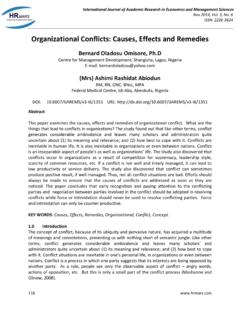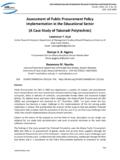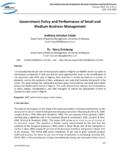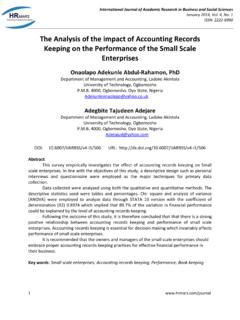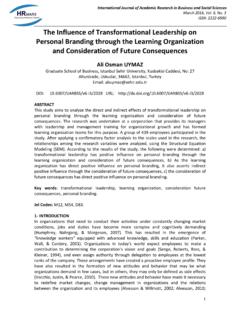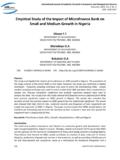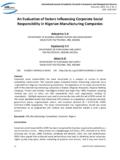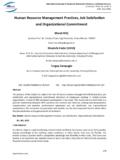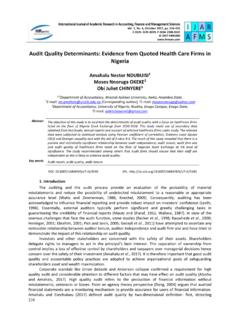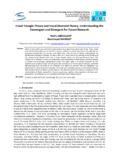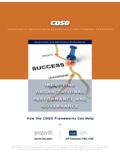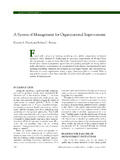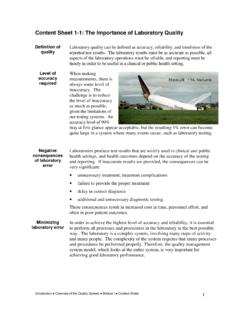Transcription of A three-Component Conceptualization of …
1 international Journal of Academic Research in Business and Social Sciences 2016, Vol. 6, No. 12 ISSN: 2222-6990 16 A three - component Conceptualization of organizational Commitment NORAAZIAN and KHALIP Department Management and Economics, Universiti Pendidikan Sultan Idris Shah, Tanjong Malim Perak Malaysia Email: DOI: URL: Abstract This paper is a conceptual based paper which gives theoretical evidence to support the idea. The paper also gives a brief overview model proposes that organizational commitment is experienced by the employee as three simultaneous mindsets encompassing affective, normative, and continuance organizational commitment.
2 Affective Commitment reflects commitment based on emotional ties the employee develops with the organization primarily via positive work experiences. Normative Commitment reflects commitment based on perceived obligation towards the organization, for example rooted in the norms of reciprocity. Continuance Commitment reflects commitment based on the perceived costs, both economic and social, of leaving the organization. This model of commitment has been used by researchers to predict important employee outcomes, including turnover and citizenship behaviors, job performance, absenteeism, and tardiness (Meyer et al., 2002). Meyer and Allen (1997) provide a comprehensive overview of the theoretical lineage of this model.
3 Key words: organizational commitment, affective commitment, normative commitment, continuance commitment. 1. Introduction Employee is the main resource for the organization. Once the organization wants to meet its objectives, first it has to meet the employee requirement up to reach the obligation level. Thus, when they are in that stage, the organization can easily access and can compete in the market, with good service and product as well as high performance. organizational commitment is considered as the most important construct of employee attachment (Sommer et al., 1996). Meyer and Allen (1997) define organizational commitment as the desire of employees to remain employed with their organization.
4 organizational commitment has strong connection, with employee behavior and performance (Benkhoff, 1997) international Journal of Academic Research in Business and Social Sciences 2016, Vol. 6, No. 12 ISSN: 2222-6990 17 2. Literature Review The three - component model of commitment developed by Meyer and Allen (1997) arguably dominates organizational commitment research (Meyer et al., 2002). This model proposes that organizational commitment is experienced by the employee as three simultaneous mindsets encompassing affective, normative, and continuance organizational commitment. Affective Commitment reflects commitment based on emotional ties the employee develops with the organization primarily via positive work experiences.
5 Normative Commitment reflects commitment based on perceived obligation towards the organization, for example rooted in the norms of reciprocity. Continuance Commitment reflects commitment based on the perceived costs, both economic and social, of leaving the organization. This model of commitment has been used by researchers to predict important employee outcomes, including turnover and citizenship behaviors, job performance, absenteeism, and tardiness (Meyer et al., 2002). Meyer and Allen (1997) provide a comprehensive overview of the theoretical lineage of this model organizational Commitment The definitions of organizational commitment are varying in studies.
6 Meyer and Allen (1997) suggested organizational commitment as a multidimensional concept that has been understood in different ways. organizational commitment appears to be behavioural (Staw, 1980), normative (Allen & Meyer, 1990), calculative (Becker, 1960; Ritzer & Trice, 1969) and attitudinal (Porter, Steers, Mowday and Boulian, 1974; Mowday, Porter & Steers, 1982). Porter et al. (1974) attitudinal concept has been widely accepted to measure the employee s commitment, measuring through attitudes and feeling toward his employing organization. three - component Model Allen and Meyer (1990), Meyer and Allen (1991, 1997), Meyer and Herscovitch (2001) developed the three - component model of organizational commitment.
7 The three dimensions of organizational commitment identified are affective, continuance and normative international Journal of Academic Research in Business and Social Sciences 2016, Vol. 6, No. 12 ISSN: 2222-6990 18 Figure A three - component Model of organizational Commitment Antecedents of Affective Commitment Personal Characteristics Work Experiences Antecedents of Continuance Commitment Personal Characteristics Alternatives Investments Antecedents of Normative Commitment Personal Characteristics Socialization Experiences organizational
8 Investments Turnover Intention and Turnover On-The-Job Behaviour Attendance OCB Performance Employee Health and well-being Affective commitment Continuance Commitment Normative Commitment Correlates of organizational Commitment Job Satisfaction Job Involvement Occupational commitment international Journal of Academic Research in Business and Social Sciences 2016, Vol. 6, No. 12 ISSN: 2222-6990 19 Affective Commitment Affective commitment is referred to as the individual s emotional attachment to and involvement and identification with the organization (Allen & Meyer, 1990). Affective commitment takes into account three main aspects namely: (1) the development of psychological affinity to a firm; (2) association with the organization; and (3) the wish to remain as a member of the organization.
9 Individuals, by developing emotional affinity toward a firm, tend to associate themselves with the objectives of the firm and support the firm in achieving these objectives (Allen & Meyer, 1990). When the employees own values are consistent with the organization s values, then the employees are able to identify with the organization and this will enable the individuals to assimilate the values and goals of the organization. Affective commitment has been linked to a wide range of positive outcomes in relation to absenteeism, turnover, organizational behaviour and job performance (Meyer & Herscovitch, 2001). Positive results can be achieved through affective commitment which can be observed through reduced absenteeism, reduced turnover, better organizational behaviour and organizational effectiveness.
10 According to Jaros, Jermier, Koehler and Sincich (1993), affective commitment is identified with desirable workplace behaviours, such as lower absenteeism rate, job satisfaction, increased productivity, personnel stability and organizational citizenship behaviour. There are certain variables that precede affective commitment. The variables can be classified into three main categories, namely: work experiences, organizational characteristics; and personal characteristics (Meyer & Allen, 1991). Personal characteristics are the demographic factors of the employees. It has been reported that the association between demographic factors and affective commitment is neither consistent nor significant (Meyer & Allen, 1991).
